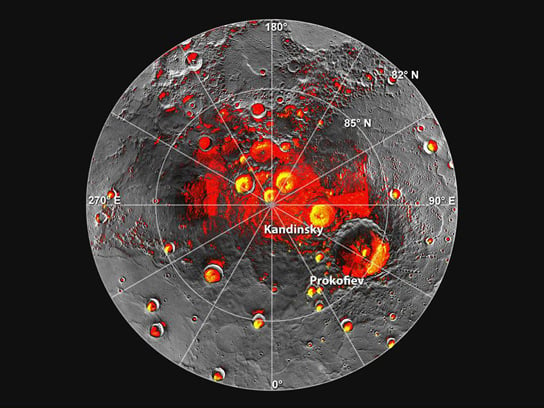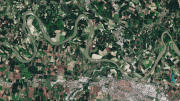
MESSENGER images polar craters. Credit: NASA
While the surface of Mercury is hot enough in some places to melt lead, the MESSENGER probe confirmed that there are about a trillion tonnes of water ice trapped inside craters.
The scientists published their findings in the journal Science (1, 2, 3) in three papers. The ice, which was long suspected, seems to be much purer than ice trapped in similar craters on Earth’s Moon. This could mean that Mercury is a better place to trap icy materials delivered by asteroids and comets.

Shown in red are areas of Mercury’s north polar region that are in shadow in all images acquired by MESSENGER to date. Image coverage, and mapping of shadows, is incomplete near the pole. The polar deposits imaged by Earth-based radar are in yellow (from Image 2.1), and the background image is the mosaic of MESSENGER images from Image 2.2. This comparison indicates that all of the polar deposits imaged by Earth-based radar are located in areas of persistent shadow as documented by MESSENGER images. Credit: NASA/Johns Hopkins University Applied Physics Laboratory/Carnegie Institution of Washington/National Astronomy and Ionosphere Center, Arecibo Observatory
The floors of many of Mercury’s polar craters are cast in permanent shadow, despite the planet’s blistering 400 °C (750 °F) temperatures. This is caused by the fact that the planet’s rotational axis is perpendicular to its orbital plane, so the poles never tip towards Sol. There are bright regions near the poles that contain meter-thick slabs of pure ice.
IR pulses fired at the planet from MESSENGER revealed that the bright regions inside darkened craters line up perfectly with ultra-cold spots on the planet, which never get warmer than –170 °C (-274 °F).
MESSENGER’s Neutron Spectrometer has spotted the signature of hydrogen, which astronomers think is locked up in ice, in those same regions. The bright spots are surrounded by darker terrain that receives more sunlight and heat. This material is a layer of about 10 centimeters that lies on top of the ice, insulating it.
The darker material could be made up of complex hydrocarbons expelled from planetary impacts. When icy bodies collide with Mercury, their components migrate over time to the cooler poles by repeatedly vaporizing and precipitating, where they get stuck in frigid polar craters. Sunlight will sometimes strike parts of the craters’ interiors, vaporizing the ice and leaving behind deposits of hydrocarbons that gradually become thicker and darker as they are chemically altered by sunlight.









Be the first to comment on "Presence of Ice on Mercury Confirmed by MESSENGER Probe"